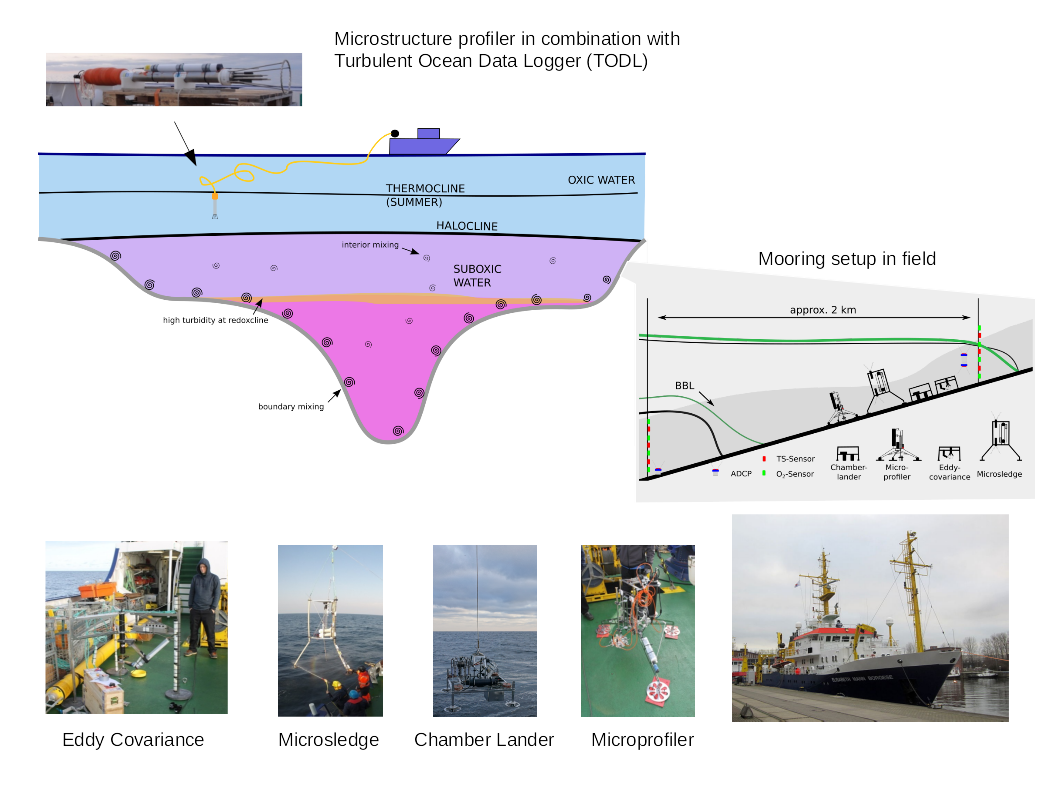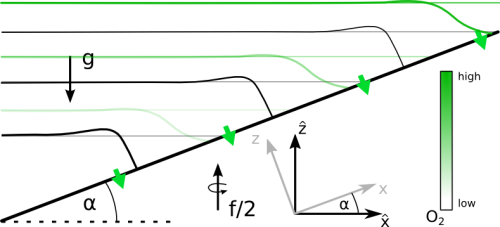
German Research Foundation, Project HO 5891/1-1: The role of bottom boundary turbulence for the transport of tracers in marine basins (ROBOTRACE)
Contact: Dr. Peter Holtermann (peter.holtermann@io-warnemuende.de)
In nearly all stratified marine basins, exchange processes between the seafloor and the interior water column play a crucial role in the basin-scale biogeochemistry of the system. Within this project the aim is to identify, analyse, and quantify the physical processes contributing to the exchange of dissolved substances between the sediment-water interface, the turbulent BBL, and the weakly turbulent interior of stratified basins. The focus will be on the effect of sloping topography, where the exchange is complicated by the interplay between BBL restratification, BBL turbulence, and sub-mesoscale processes that are assumed to determine the lateral exchange of fluid between the BBL and the interior. These processes will be investigated here with a combined experimental, theoretical, and numerical modelling approach.

Panel (A): Conceptual sketch of the stratified near-bottom region (isopycnals in black) near a sloping bottom boundary layer (BBL: gray-shaded area). Coloured contour lines indicate isolines of oxygen (green) and sulphide (purple); corresponding sediment-water fluxes are denoted by arrows. Panels (B-D): Different scenarios illustrating the effect of near-bottom turbulence on oxygen profiles (in colour). Lower part of the BBL with (B) weak BBL turbulence, thick DBL, and therefore small sediment-water oxygen fluxes, and (C) strong BBL turbulence, thin DBL, and therefore large sediment fluxes. (D): View of the entire BBL (note the different vertical scale) with decreased oxygen fluxes at the upper edge of the BBL, leading to low concentrations within the BBL.
Project Structure
The project is divided into an in Situ part and an modelling part, both parts benefit from the results of the other.
1: Field measurement
Field work consists of the combination of turbulence measurements with oxygen concentrations yielding the turbulent transport of oxygen. For this purpose several different moorings are deployed during the project (see figure below for an overview of used equipment).

2: Modelling
The oxygen transport processes will be modelled with the 1D respectively 3D models GOTM and GETM. Below a concenptual sketch of oxygen transport processes in a 1D model with a sloping topography, a developed bottom boundary layer in a rotating reference frame.

The role of bottom boundary turbulence for the transport of tracers in marine basins
In nearly all stratified marine basins, exchange processes between the seafloor and the interior water column play a crucial role in the basin-scale biogeochemistry of the system. Within this project the aim is to identify, analyse, and quantify the physical processes contributing to the exchange of dissolved substances between the sediment-water interface, the turbulent BBL, and the weakly turbulent interior of stratified basins. The focus will be on the effect of sloping topography, where the exchange is complicated by the interplay between BBL restratification, BBL turbulence, and sub-mesoscale processes that are assumed to determine the lateral exchange of fluid between the BBL and the interior. These processes will be investigated here with a combined experimental, theoretical, and numerical modelling approach.

Panel (A): Conceptual sketch of the stratified near-bottom region (isopycnals in black) near a sloping bottom boundary layer (BBL: gray-shaded area). Coloured contour lines indicate isolines of oxygen (green) and sulphide (purple); corresponding sediment-water fluxes are denoted by arrows. Panels (B-D): Different scenarios illustrating the effect of near-bottom turbulence on oxygen profiles (in colour). Lower part of the BBL with (B) weak BBL turbulence, thick DBL, and therefore small sediment-water oxygen fluxes, and (C) strong BBL turbulence, thin DBL, and therefore large sediment fluxes. (D): View of the entire BBL (note the different vertical scale) with decreased oxygen fluxes at the upper edge of the BBL, leading to low concentrations within the BBL.